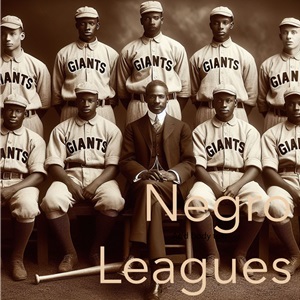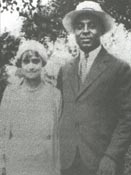 Enslavement
Enslavementto freedom


Moving Through and Meeting the Challenges
of the Twentieth Century
Study Areas
There Were Giants in Those Days: Harrisburg and the Negro Baseball Leagues
Part Two
League Play and Major League Integration
Spurned by the white baseball leagues, Black players, managers and owners began forming their own leagues beginning with the Negro National League in 1920, which brought together the large Western teams. As the popularity of Black Baseball increased in the 1920's, another league, the Mutual Association of Colored Baseball Clubs, was formed. Better known as the Eastern Colored League, it encompassed the large Eastern teams, and it also set the stage for the first Negro World Series in 1924. (Knutson; Knorr and Jackson)
 Colonel Strothers brought his Harrisburg Giants to the Eastern Colored League in time for the 1924 season, and they would stay with the league until just before it broke up in 1928. During that time the Harrisburg Giants compiled an impressive league record, reaching their zenith in 1925 with a team that included the dream outfield of Rap Dixon, Oscar Charleston and Fats Jenkins. Only the Hilldale Giants, the defending league champions, stood between Harrisburg and the 1925 Negro League World Series. Hilldale triumphed, though, in a series of games marred by Harrisburg manager Charleston's charge that the umpiring and scheduling were unfairly crafted in Hilldale's favor.(Knorr and Jackson; Knutson)
Colonel Strothers brought his Harrisburg Giants to the Eastern Colored League in time for the 1924 season, and they would stay with the league until just before it broke up in 1928. During that time the Harrisburg Giants compiled an impressive league record, reaching their zenith in 1925 with a team that included the dream outfield of Rap Dixon, Oscar Charleston and Fats Jenkins. Only the Hilldale Giants, the defending league champions, stood between Harrisburg and the 1925 Negro League World Series. Hilldale triumphed, though, in a series of games marred by Harrisburg manager Charleston's charge that the umpiring and scheduling were unfairly crafted in Hilldale's favor.(Knorr and Jackson; Knutson)
Hilldale went on to play the West's Kansas City Monarchs for the 1925 Negro World Series title in a rematch from 1924. Unlike the previous year, however, Hilldale took the series, winning a decisive five games to the Monarchs' one. (Knutson)
Colonel Strothers removed his Giants from the Eastern Colored League after the 1927 season, achieving an overall league win average of .576. The Eastern League folded in the Spring of 1928, and the Negro National League was already experiencing problems because of the illness of its founder, Rube Foster. With Foster's death in 1930 the last league foundered and broke up the following year. This lack of league structure, combined with the worsening effects of the Great Depression in 1932 and 1933, forced Black Baseball into more exhibition games and barnstorming schedules. (Knorr and Jackson; Knutson)
Harrisburg's ball club experienced its own lack of direction with the death, in 1933, of Colonel Strothers. Strothers had owned the Harrisburg Giants for more than forty years, and had seen most of Black Baseball greats pass through his city, either as players for the Giants, or as opponents. His death came just days before a scheduled game between Harrisburg and the New York Black Yankees, and in tribute, two former Harrisburg Giants, Rev Cannady and Fats Jenkins, attended Strothers' funeral in their ball club uniforms on the day of the game. A decade later, another Harrisburg Black ball club, the Strothers A.C., memorialized the Colonel, and included Steelton's Rap Dixon and his younger brother Paul Dixon in their outfield. (Knorr and Jackson)
After the breakup of the first two major Negro Leagues, other leagues came and went, most lasting only a few seasons. Out of this period of change finally emerged the reinvented Negro National League, but now as an eastern league. The Negro American League, in the west, provided that region with a league structure. In the meantime, however, another Black Baseball phenomenon had caught on in the absence of strong leagues: the East-West All-Star Classic games. From 1933 through the years of World War II, this annual event grew in popularity with fans of all races until its attendance outdrew even the major league all-star games. These events, combined with the revived Negro League World Series in 1942, drew the attention of major league owners. (Knutson)
World War II, like the Great Depression a decade earlier, disrupted the schedules and structure of Black Baseball. The Harrisburg-St. Louis Stars went on a national tour to promote the war effort instead of competing in the Negro National League.
Other Negro National League teams played exhibition games in Harrisburg's Island Park beginning in 1943, often playing local military teams from nearby Olmstead Air Force Base in Middletown, the Army Depot in New Cumberland, and teams from Fort Indiantown Gap. Held as war effort fund raisers, these games featured major and minor league players now in uniform, playing against Negro players. The games drew Black troops stationed at Fort Indiantown Gap for Quartermaster training to Harrisburg, along with white troops, to observe the integrated games. (Knorr and Jackson)
By the end of the war, some major league owners felt that America was finally ready for integrated major league baseball again, something that the country had not seen since 1887. It was Brooklyn Dodgers general manager Branch Rickey who took the initiative in late 1945 and signed 26-year-old Jackie Robinson to a deal with the minor league Montreal Royals. After a year with the Royals, Rickey moved Robinson up to the major league Dodgers, and into his spot in history. Jackie Robinson's move to baseball's major leagues in 1947 signaled the beginning of the end of Black Baseball, as Black and white fans gradually began flocking to major league games as more Black players were signed. ("Negro Leagues;" Knutson)
Black Baseball in Harrisburg had a few more good years, with an amateur team managed by former Giant Spottswood Poles active in the late 1940's and early 1950's. Also active in local Black Baseball at this time were local men Wilbur Fordham, Tom Healey, Leo "Psyche" Burnett, Russell Royster, Robert Pierce and Reid Poles, nephew of Spottswood Poles. (Knorr and Jackson)
Although the era of Black Baseball in Harrisburg has passed, interest in the subject is increasing. A dedicated core of local historians is working to keep the memory of the Harrisburg Giants, Colonel Strothers, and memories of those talented individuals who played in Harrisburg, those true giants of the Black diamond, alive.
Read Part One: "Early Games and the Independent Era"
Works Cited:
Brillhart, Fred "Fredrico." "Spottswood Poles." 1998 Commemorative Program: 2nd Annual Negro League Commemorative Night. Harrisburg, PA, 1998. n.p.
Knorr, Ted and Calobe Jackson, Jr., "Blackball in Harrisburg.", 1998 Commemorative Program: 2nd Annual Negro League Commemorative Night. Harrisburg, PA, 1998. n.p.
Knutson, Signe. A Brief History of the Negro Leagues. 27 June, 1999. A Look at the Negro Leagues. 19 March, 2002 <http://my.execpc.com/~sshivers/History.html>
"Negro Leagues." Microsoft Encarta Encyclopedia Deluxe, 2001. CD-ROM, 2000.
Related Articles:
Blackball in Harrisburg Original research article by Ted Knorr and Calobe Jackson, Jr.